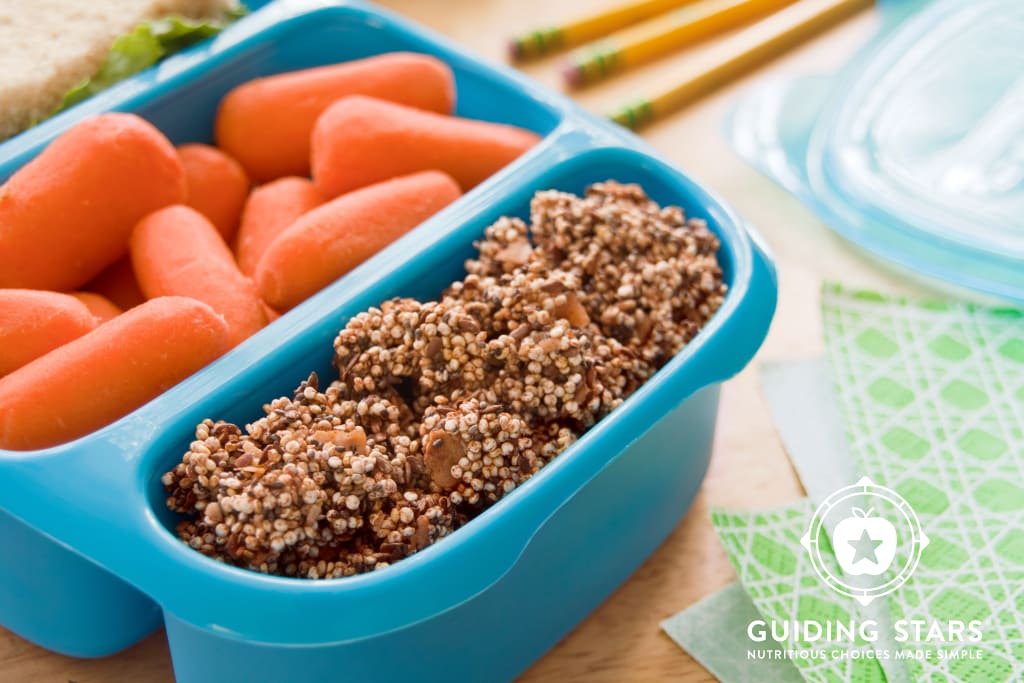A vegetarian middle schooler? An adolescent who only wants to eat “natural foods.” Neither is rare. Both can be frustrating for caregivers who want to be supportive, but see their adolescent’s food choices as limiting, inconvenient, or sometimes unnecessary. While a young person’s desire to control their diet may seem out “of the blue,” it’s quite common and not always a bad thing. Done correctly, a shift in food preference gives an adolescent an opportunity to consume a balanced diet, understand where their food comes from, and possibly learn a bit about the food industry. There may even be a chance that the rest of the household can learn from their young family member.
Quinoa Granola
This granola is an easy recipe for young teens to learn, engaging them in the process of choosing snacks that smartly fill the gaps between meals.
View recipe »Let your middle schooler know that adopting a new diet requires a bit of nutrition education to ensure they are making healthy choices. A few key lessons:
Being vegetarian means choosing plant-based proteins.
Adolescents and teens are quick to say they are vegetarian and no longer eating meat. But they generally don’t have a protein plan, which is not okay. It’s essential for young people to understand that being vegetarian means choosing plant-based protein. Viewed through this lens, the vegetarian diet truly becomes about emphasizing alternative proteins, not just about “not eating meat,” which is what most young people are focused on.
Understand “natural” and encourage understanding of local food scene.
The movie they watched in health class, the companies and celebrity influencers they follow on Instagram, and the websites they stumble upon all contribute to your child’s understanding of the food industry. The messages contained within these images can be very influential, contribute to a fear of certain ingredients and brands, and serve as a catalyst for diet change. Help your child understand background, funding, and other factors that influence the production of these documentaries, images, and the food industry. If your child is concerned about food production and wanting to eat “natural,” consider introducing them to B Corporations and brands that have sustainability and accountability missions. Choose more local products to support smaller farmers in your own community and help them understand the many options we have to control our food choices.
Trends come and go, but health sticks around.
Share a bit of diet history and maybe even some studies showing what diets consistently improve health outcomes with your adolescent. Help them see that commercial diet come and go, and that what trends today may not be popular tomorrow. Emphasize sound diet advice that includes adequate protein, colorful produce, whole grains and a balance of nutrients.
Teach deeper food independence.
If your adolescent wants to adopt a new lifestyle, then they need to embrace all the pieces of bringing their new diet to life. Since food independence is what they are seeking, the shopping and planning that goes along with that should be encouraged.
Shopping List
- If your child is choosing to follow a vegetarian diet, use this list to help them select plant-based proteins.
- Pick up containers that making packing lunch easy including some that will work for keeping foods warm.
Lunch Plan
- Sit with your child to create a list of 5-7 “go to” lunches that can be assembled by you or your adolescent without too much extra effort. Use this list to guide your shopping list.
- Help them do some food prep ahead of time to have diced and sliced veggies and fruits on hand for easy packing.
Building Balanced Lunches
- The blueprint for a balanced lunch relies on selecting foods from each food group.
- Proteins: Use this guide to ensure your child packs enough protein to be satisfied.
- Whole grains: Emphasize whole grains by choosing breads, wraps, crackers, and grains like brown rice, quinoa, and multigrain pasta, which can be used for cold grain salads.
- Fruits & Vegetables: Remind your child that they need a fruit, vegetable, or both with lunch to round out the meal and help meet daily intake goals. Encourage in-season, local produce to emphasize supporting local farmers and the environment.
Packing Snacks
Nutritious, sustaining snacks that “fill the gaps” in daily nutrition and help your child meet their daily goals are an important part of their diet. Lean on fruits and vegetables along with cheese sticks, nuts, granola bars and similar options.
